A lot of people say that Costa Rican Food isn’t all that great and that it’s unimaginative at best, however I beg to differ. Having lived here for just a year and a half, I have been able to sample a lot of local cuisine, but I am far from an expert. Food in Costa Rica has a rich history and deep meaning for the people here, which for me deserves a lot of respect when being critical of it’s food.
Even though I’ve been living here for over a year and a half, I haven’t quite yet embraced preparing typical food at home. Okay, so maybe I have gotten too comfortable with what I like to cook and the ingredients I know well, but now is the perfect time to explore.
Recently, I vowed to find the most unique dishes to Costa Rica and tweak them into the perfect recipes. But before we get down to business, we have a few terminologies to sort out and some background to familiarize ourselves with. First, the terms I’ll be using in this post may seem foreign to you (duh, because they are) but they’ve become a permanent part of my language living here. Ticos or Ticas are the native people. The name originates from their specific dialect of Spanish and how they’ve always added a -tico or -tica to the end of words, as in ‘little’ or ‘small’. For example, I chuckle when I hear someone say ‘quiero el chikitico’ or ‘I want the small one’. This is not common to end words with -tico or -tica, but it is common in any Spanish-speaking country for them to say “cafecito” (little coffee), “pancito” (little piece of bread) or “whiskito” (you guessed it: a little whiskey).
Here’s a little cultural background. If there is one common thread among all Ticos, it’s their passion for futból and their devotion to either La Liga or Saprissa. Here, your blood either runs purple and white or red and black, or you’re not Costa Rican at all. You know when it’s game day and it’s even easier to know when a goal is scored b/c no matter where you are in the country there are car horns blaring when there’s a GooooooOOOOOOOOOOaaaaaaaaaallllllll!!!!!! And what do the Ticos do before, during and after the games? Why eat of course. Which is why I chose the recipes I did, so you could maybe get the taste of what a traditional meal of the futból-loving Ticos is like.
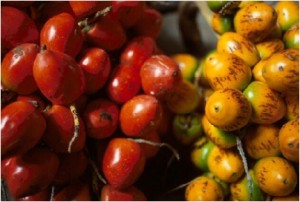
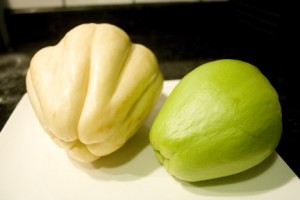
Now for the ingredients that you’ve most likely never heard of. First we’ll start off with the pejibaye, or peach palm, which grows and is exported more in Costa Rica than any other country. The flavor is similar to a boiled peanut but with a milder flavor and a different texture. You can find them all over the sides of the road where locals set up giant pots boiling over a flame. Ticos love to eat them with mayonnaise and salt, but I’ve found them to be most delicious as a creamy soup. You can find them for about $2-3 for a kilo (2.3 lbs).
Then there’s a chyote, which is a type of squash that comes in either white or green and is a very inexpensive vegetable use for side dishes and what they call ‘picadillo’, which essentially means small pieces. Chyotes are about $0.30 a piece and recipes typically call for 2-4 units and rarely do you need any more unless you’re serving more than 6 people. But I beg you to be careful when you’re peeling and chopping the chayotes. You need to grab the vegetable with a towel or wear gloves. The reason for this is because they leave a strong film on your hands that acts like children’s glue but much, much worse. There’s not real way to get it off until it wears itself off.
Now to the recipes so you can judge for yourself if you agree that Costa Rican food isn’t noteworthy, but I have a hunch that you’ll love it.
Contents
Classic Costa Rican Recipes
Crema de Pejibaye – Peach Palm Soup
Ingredients
- 18 Pejibayes (cooked, peeled, pitted and chopped)
- 6 Cups of Chicken Broth
- 1 Cup of Heavy Cream
- 1/4 Cup butter
- 4 Tbsp of all purpose flour
- 2 yellow onions, finely chopped
- 3 bay leaves
- Bundle of 1 sprig of thyme and rosemary
- Salt and pepper to taste
Directions
- In a medium to large pot, melt the butter and saute the onions until they begin to caramelize
- Slowly mix in the flour and then add the chicken broth. Bring to a boil.
- Add chopped pejibayes, turn down the heat and simmer with the bay leaves and bundle of thyme and rosemary for 10 minutes. Remove bundle and bay leaves.
- Using an immersion blender, blend the contents of the pot until smooth
- Simmer for 10 more minutes to allow it to thicken, and add salt and pepper to taste
- Garnish with fresh chopped cilantro and serve hot.
——————————————————————————————————————————————————————–
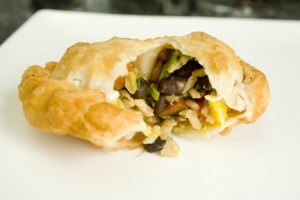
Gallo Pinto Empanadas
Recipe makes 18 empanadas
Empanada Dough Directions
- In a medium-sized bowl mix 3 cups of All-Purpose flour and 1 tablespoon of salt.
- Cut 1/2 cup room temperature solid vegetable shortening into pieces and place in bowl with flour mixture. Using a pastry cutter, cut in shortening until you have a cornmeal texture. If needed break up large pieces with your hands.
- Slowly incorporate 3/4 cup of luke-warm water, adding a little at at time until a dough ball forms. The dough should not be sticky and should be kneaded about 10 times.
If needed, add more flour or water to reach the appropriate consistency. - Cover with plastic wrap and let rest for 1 hour. If you’re making the dough in advance, wrap with plastic wrap and refrigerate. However, bring dough to room temperature before assembling empanadas.
Filling Ingredients
- 1 Cup Dried black beans
- 1 Bay leaf
- 1 medium Yellow onion
- 4 Garlic Cloves
- 3 Cups Water
- 1 teaspoon salt
- 1 cup Brown or White rice
- 1/2 Red bell pepper
- 1 Green onion
- 1/8 Cup Fresh choppded cilantro
- 2 Whole Eggs
- 2 Tbsp Unsalted butter
Filling Directions
- Soak beans in a bowl of water overnight and then drain.
- Finely chop the onion. In a slow-cooker, place black beans and three cups of water, the bay leaf, half of the chopped onion and cook on high for 3-4 hours.
- Strain off excess juices and remove bay leaf.
- Bring two cups of water to a rapid boil and pour in rice. Season with 1 teaspoon of salt and let cook on medium heat for 15-20 minutes until rice is fully cooked.
- In a large fry pan, melt butter and saute remaining onion, garlic and bell pepper. Cook until onion is translucent, add green onion, then pour in rice and beans and mix until incorporated.
- In a separate pan, scramble egg with milk until fully cooked. Add egg to rice and bean mixture.
- Finally, chop cilantro and add to the mixture. Allow to cool.
Empanada Assembly
- Thoroughly clean the work surface and give yourself plenty of room.
You’ll need flour, a rolling pin, a circular cutter (6-8”), spoon, water, cookie sheet and your filling. Sprinkle flour on the work surface and pull a piece of dough off that’s about the size of a lime. - Begin to flatten the dough ball in all directions until the dough is roughly 2 millimeters thick. The dough shouldn’t stretch much further than the diameter of your cutter, or you might have used too much dough.
- Press the cutter through the dough completely. Remove excess dough and incorporate it into the next dough ball. It’s important to note that once the dough has been rolled and stretched, it is much harder to do it a second time, so using the least amount of dough per cut is ideal.
- Once you’ve rolled out the dough and cut out the circle, it shouldn’t shrink any. Moisten the edges by dipping your fingers into egg wash and gently spreading a thin layer around the edges.
- Spoon out 2-3 tablespoons of filling onto the upper half of the circle. Fold the bottom half of the dough up over the filling and press the edges together repositioning the filling inside if needed. It’s important to have the right amount of filling so it won’t break open or leave it hollow after cooking. You should fill it just enough to still get the empanada to close.
- There are many ways to close and shape empanadas but I prefer the pinch and twisting closure. Starting with one edge pinch the edge between your finger and then fold the corner up over itself by 2 cm and pinch the new fold to seal it. Repeat the motion all the way around the empanada by pinching and twisting the dough to create a rope-like edge. When you reach the other edge simply tuck the corner under and pinch closed to seal it off.
- To cook them, heat up some vegetable oil, coconut oil, palm oil or peanut oil in a medium-sized pot to a medium-high temperature. Be sure to test your oil before dropping in the empanadas, if you drop in a little piece of extra dough, it should boil easily but not crackle, pop or boil too rapidly. If this happens, reduce the heat of the oil before submerging the empanada. When the oil is ready, submerge two or three empanadas in the oil and allow them to cook for 4-6 minutes until golden brown. Watch them carefully so they don’t burn.
——————————————————————————————————————————————————————–

Barbudos – Egg Fried Greenbeans
Ingredients
- 30 Greenbeans (washed and ends trimmed)
- 1 Tbsp All Purpose Four
- 1/3 cup of light olive oil for frying
- 2 eggs
- 1 tsp ground cayenne pepper
- Salt to taste
Directions
- In a medium-sized sauce pan, boil green beans in water with salt until al dente, with a slight crisp.
- Separate the eggs with whites in a small bowl and the yolks in another. Beat the whites until slightly stiff. Add the yolk, flour and salt and mix.
- Form groups of 6 green beans, soak in batter and fry in a pan with olive oil on medium-high heat, turning once after 2 minutes.
- Place in a hot oven while you’re cooking the rest. Eat immediately.
——————————————————————————————————————————————————————–
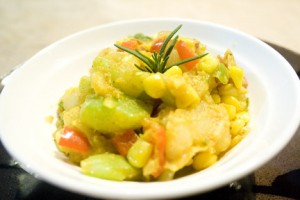
Picadillo
Ingredients
- 2 Whole Chayote
- 1 1/2 cups Frozen Corn
- 1 Medium Yellow onion
- 5 Cloves of Garlic
- 2 Medium Bell Peppers
- 2 Stalks Celery
- 1 cup Cilantro
- 1 Argentinean Chorizo
- 1 Tablespoon Cajun Seasoning
- 2 tsp salt
- 2 tsp Black Pepper
- 1 Tbsp Cumin
- 8 Strips bacon (6 if they are extra thick)
- 3 Tbsp Unsalted Butter
Directions
- Using gloves, peel chayote and remove pit. Cut into 2 cm pieces and place into a medium-sized pot. Cover with water and boil for 15 minutes. Drain and set aside.
- Meanwhile, fry bacon in a large fry pan turning occasionally until well-cooked but not burnt. Remove from pan, let cool and break into small pieces by hand.
Peel and dice the onion, mince the garlic and chop the bell pepper into small pieces. - In the same pan with bacon grease, add chorizo (remove from casing), onion, garlic, bell pepper and celery. Cook on medium-high heat until slightly soft, about 2-3 minutes breaking up the chorizo as it cooks.
- Add butter, corn, cilantro, chayote, cajun seasoning, black pepper and cumin. Mix well. Salt to taste (varies depending on the type of cajun seasoning).
——————————————————————————————————————————————————————–
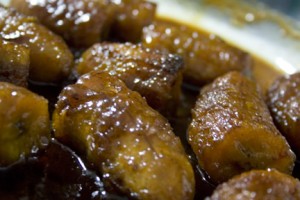
Sweet Plantains
As seen in a previous post.
Ingredients
- 4-6 ripe plantains, cut into 1″ slices
- 1/2 Cup of margarine or butter
- 1 1/2 Cup of sugar
- 1 tsp of ground cinnamon
- 1/2 tsp ground nutmeg
- 1/4 tsp ground cloves
- 1 lime
- 2 Cups of water
- 1 tsp pure Vanilla extract
Directions
- In a large pan, melt the butter and saute the plantains on medium heat until golden. Add 1 cup of sugar, cinnamon, nutmeg, clove, lime juice and vanilla. Stir for 1 min.
- Add water and sprinkle on the remaining sugar.
- Reduce heat to low and cook until the liquid is reduced and caramelized. Serve hot, or let cool.


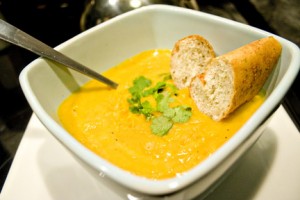

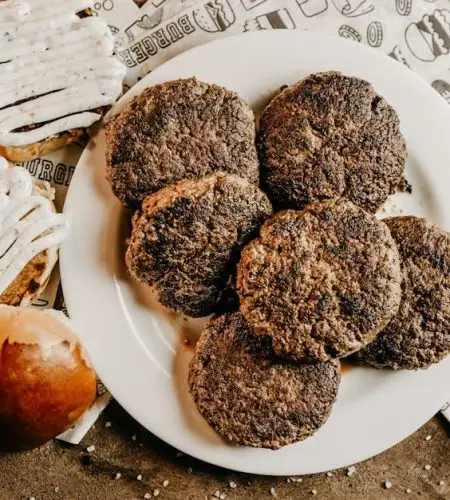
Can you give me any recommendations or best places to try all the 5 best Costa Rican foods. I’ll be staying in San Jose, Monteverde, Puerto Viejo, Tamarindo, and Manuel Antonio.
Thanks
-jen
[…] supper I made some pinto gallo empanadas. I forgot to put the scrambled egg inside with the rice and bean mixture, so had scrambled eggs […]
How do you cook the empanadas?
Good question. Sorry the post was a little unclear. These empanadas should be deep fried because of the shortening used. You should bring your oil up to a medium-high temperature and fry for 4-6 minutes or until golden brown. If you’d like to bake them instead, substitute real butter in the same quantity for the shortening and bake on 400 degrees F for 10-15 minutes until golden brown.
THANK YOU for posting this. My husband and I went to Costa Rica on our honeymoon and we loved the food. We’ve had a hard time finding good recipes since we’be been back home though. I miss having fried plantains and queso fresco every morning with breakfast.
We went all over Costa Rica (San Juan, La Fortuna, Monteverde, Manuel Antonio). We drove and we’d stop at the small, local places. However, when we were in Manuel Antonio, we ate a Raffael’s Terazzas (or something like that). It overlooked the ocean. Anyway, we had the BEST Paella there and I have not been able to find a recipe like it. We found that the food differed all over the country. We’d try to get the Casada at each place we ate.
Do you happen to have a paella recipe, or can you point me in a good direction? Thanks for the fried plantains recipe. I’m going to have to try it. We’ve tried a few, but none have been quite right.
I’ve also tried a few Gallo Pinto recipes and we found one that was close. I’m glad we brought a bottle of Lazano back with us!
Hey Amber, thanks for the wonderful comment. I’m not sure if Paella is really that typical in Costa Rica, my guess is you were at a place with a Spanish or Peruvian influence. Arroz con Pollo is typical in CR but maybe you had one with seafood. Here’s a great Paella recipe with calamari and mussels among other things: http://www.jamieoliver.com/recipes/seafood-recipes/paella
I hope this was helpful. Glad you liked the post.
Just wanted to tell you that this is probably the most authentic Costa Rican recipe site I have seen so far. I was born here in the states, but my mother and grandmother were born and raised in Costa Rica. I grew up eating purely typical Costa Rican food. I was so happy to see all of the comfort foods my grandmother made me listed here, especially the barbudos. My grandma would saute some onions and tomatoes and we would pour it over our barbudos. YUM! Thanks so much for posting! Hoping to find a recipe for the “Soda Tapia” type of ice cream I would eat when I would visit as a youngster…The “helados de natilla”. Please let me know if you come across one!
Hey Veronica,
Thanks for your amazing feedback, it’s great to hear. I only lived in Costa Rica for 2.5 years but I loved exploring the food culture there. I don’t recall having the ice cream at Soda Tapia but I’ll keep my eye out for a recipe for helados de natilla. Sounds delicious! The natilla in CR is way better than our sour cream here. It’s nice and creamy without the bite, which I like. Thanks again.
Gonna go Guancaste, Costa Rica
looking forward to the food so back here in Canada,where I’m from,I figured I’d start with the coffee
Any suggestions of food&activites not to Costa Rica without doing?
Just something considering activites I am in a wheelchair but can walk with Help
Hi there. I’m in love with Tamarindo and Playa Avellanas but really, it’s tough to get around in Costa Rica even if you can walk great. I would suggest doing guided tours where you can and stay in populated areas with paved roads. I would make sure to hit the volcano and lake in Arenal and see playa conchal as well in Guanacaste. There are hot springs all around that area, so you’ll want to find them too.
Good luck!
For those visiting Costa Rica, if your itinerary takes you to/through Orotina (a small town in the Alajuela province), you’ve got to try the rotisserie chicken that is on the side of the main road coming into Orotina from San Jose. I don’t even remember a sign in front of the place, but you can see the chickens roasting in the ovens. We just dubbed it “crack chicken” because it was so addictive! Once we discovered it, we ate it twice a week during the 9 months we lived there. Also, the best pizza we ever had was from Orotina….Brasha Pizza. Someday, I will return just for the pizza. It is THAT good.
On another note, we loved the “enchiladas” which are nothing at all like a Mexican enchilada–this is found in a panaderia (bakery). It’s a puff pastry thing (not sweet, kind of like a flaky delicious pie crust) filled with a potato/meat mixture. My husband loved the tamales there, too. Again, these are nothing like the Mexican version you may be used to. I love Mexican tamales but did not care for the Costa Rican variety.
Hi,
thank you for sharing those wonderful recipes!
Do you by any chance can send me the recipe for “Costa Rican enchiladas”.
Than you in advance!
Janet
Hi Janet,
Thanks for your comment and question, however, I’m not sure I really know what a Costa Rican enchilada is like. I can’t say I ever have had them. I have a few recipe books from Costa Rica and it’s not in there either. So sorry I can’t help.
Hi – great recipes! Do you have a recipe for slow cooked chicken or pork, the way they serve it in the “Sodas?” Many thanks!!
Hey Christina, I don’t have a recipe for exactly how they do it in Costa Rica, but I do know that the slow-cooked pork has a lot of onion, bell pepper and cumin in it. We just did some pulled chicken with those ingredients and a can of diced tomatoes and it turned out really great. Good luck!
I just spent 2 weeks in Silencio, Costa Rica with my daughter who lives there. I found most of the food very tasty. My favorite was the patacones (fried plantains)served with their ketchup/mayo sauce. Do you have a recipe for the patacones? I also would like a recipe for the tres leche cake. I heard about it while I was there but never got to taste it.
I really like your website. I just happened upon it today but will definitely be visiting it again.
Hi Jane, thanks for the comment and kind words. For the patacones, they are really easy. You basically take green plantains (very green, not ripe ones) and cut them in to 1″ thick slices. Then heat up a pan with a few tablespoons of coconut or high heat oil on medium-high heat. Use a tortilla press or something flat to smash the plantain slices and fry them on both sides until golden.
For the tres leches, there are a lot of recipes out there but I have not perfected my own. You’ll have to find a Latina grandmother to show you how 😉
I also lived in Costa Rica for a couple years. Like the recipes you put in, they are all good. I am looking for a recipe made with green beans cut up into tiny pieces. It is a picadillo, also, how about the recipe for a picadillo made with mayo and beets? I found they made many types of picadillo and some were served hot and some were served cold. They all had one thing in common, they had ingredients that were chopped very finely. Outside of that common thread, they were all very different, but extremely flavorful. I found they used beets, green beans, potatoes, chyote, and any other firmer vegetable. Some had a small amount of meat, but most didn’t. Some could be considered simple to hash. I have some different recipes, but don’t know if you want them.
Hi Joyce, that would be great if you could comment with some additional recipes. Or you can email them to me at ashley@cheapfoodhere.com and I’ll put another post together. Thanks!
Your recipes look fabulous! One question – for the pastry is the solid vegetable shortening Crisco?
Hi Elisabeth, yes, vegetable shortening is Crisco or the Latinos use Manteca. But it’s all the same. Solid shortening. Good luck!
[…] entrée, we made Gallo Pinto Empanadas. We made the pastry (which I still get excited about, because although it’s not difficult, I am […]
I was born in Costa Rica and came here 30 years ago. I love to cook and I am always making “tico food” (that’s what my husband calls it).
I wanted to share my “Queque de tres leches”. I saw that someone would like the recipe. Tres Leches Cake
Cake:
1-cup cake flour, plus extra for pan
1-teaspoon baking powder
1/2-teaspoon salt
1 stick unsalted butter, room temperature
1-cup sugar
5 whole eggs
1 1/2 teaspoons vanilla extract
Milks (Mix them all together)
1 can evaporated skim milk
1 can sweetened condensed skim milk
1-cup half-and-half (I use skim milk without sacrificing flavor, but you can use half-and-half if you want a richer cake)
Preheat the oven to 350 F. Prepare a 13 by 9-inch pan and set aside.
Beat the butter on medium speed until fluffy, approximately 1 minute. Decrease the speed to low and with the mixer still running, gradually add the sugar over 1 minute. Add the eggs, 1 at a time, and mix to thoroughly combine. Add the vanilla extract and mix to combine. Add the flour mixture to the batter in 3 batches and mix just until combined. Transfer the batter to the prepared pan and spread evenly. This will appear to be a very small amount of batter. Bake for 20 to 25 minutes.
Remove the cake pan and while hot poke holes with a fork all over the cake and pour the mixed milks slowly until absorbed. Allow the cake to cool completely.
I like to ice the cake with Cream Cheese frosting. Any cream cheese frosting recipe would do. Store bought frosting is fine. However the Costa Rican typical recipe has whipped cream frosting. Any whipped cream frosting recipe would do.
And for those of you who don’t want to go through the trouble here is the Cheaters Tres Leches Cake – Prepare a Beatty Crocker Yellow Cake mix according to instructions. Mix the milks as described above and pour over the hot cake. Spread the frosting when the cake is cold and voila!!
I am THRILLED to see this blog and your information! I’ve been living in Costa Rica for almost two years and this is the first post I’ve seen that had to do with cooking like a tica! So, so excited! Thank you a million times for your efforts to continue this site!!!
You’re welcome. Enjoy!
Hello,
I am soon to move to St. Petersburg. My husband is Tico and looking for a good restaurant to find ceviche and gallo pinto! Any recommendations for the area would be so appreciated! thank you!
Hi Heather!
We have yet to find a place with gallo pinto but there are a few places around that have good ceviche. The restaurant called Ceviche has a few locations and decent ceviche, but not the typical Costa Rican style but more a little fancier: http://ceviche.com/cevichemenu/dinnermenu/
Good luck in the move!
I will update if I find anything in the area! Perhaps we will open a food truck with some good Costa Rican dishes. I would love to grow chayote and have that on the menu as well!
I belong to an ethnic cooking group and I plan to do a Costa Rican meal. I will do the entree and 5 others will do rest. Need recipes, that I can obtain ingredients, for appetizer, salad, dessert, vegetables or something to supplement the meal.
Thanks for your comment. Hopefully you have success and like the recipes on this post! Let me know how it turns out.
[…] dinner: Gallo Pinto Empanadas served with homemade […]
What a great list of foods and recipes, thank you! I miss the fresh fruit spreads there. I did get to learn how to make homemade tortillas which was fun.
Loved the recipes but wondering if you have one foe chilera, pickled veggies that is typically served over rice.
Loved chilera! I don’t have a recipe on the site for that one. So sorry.